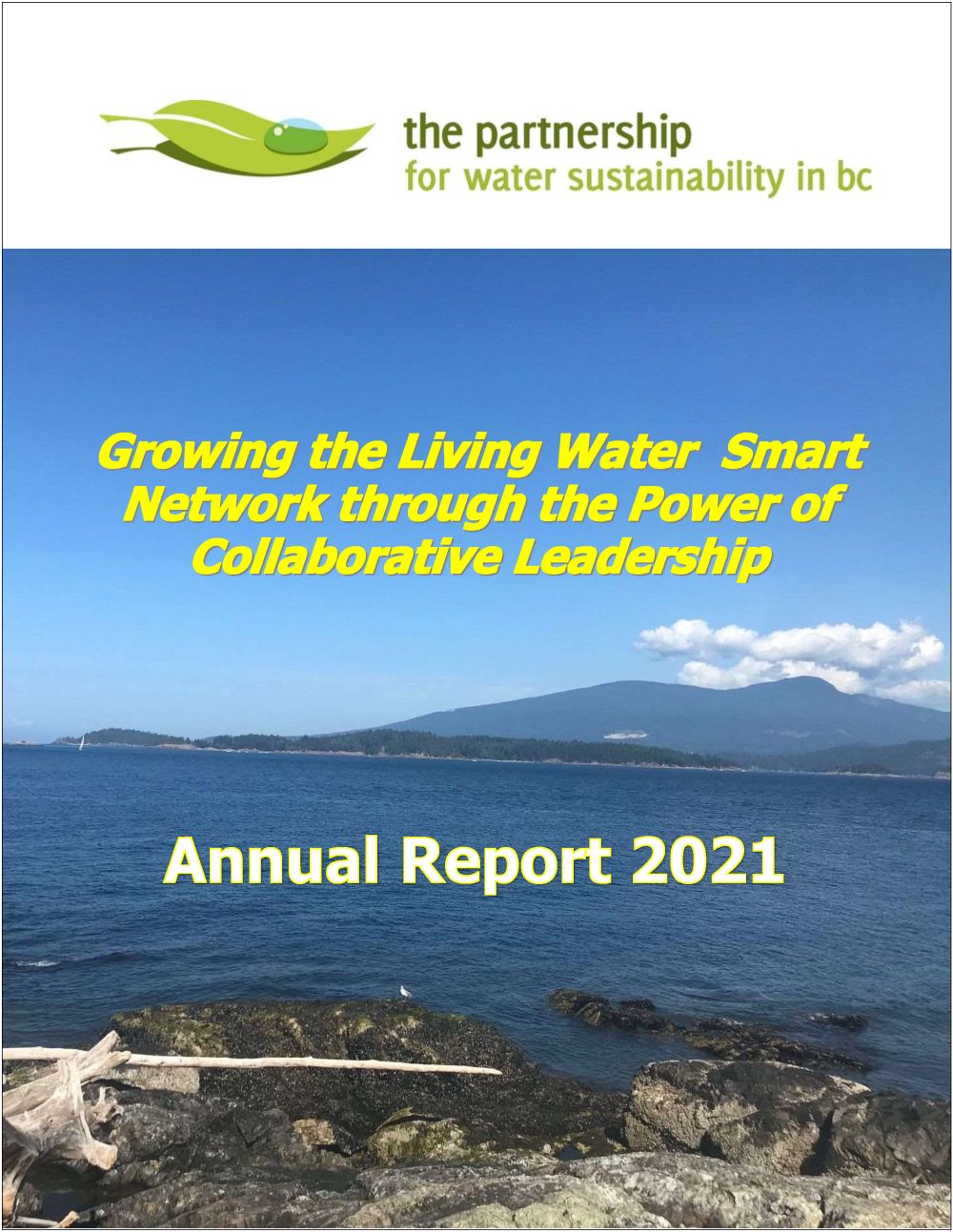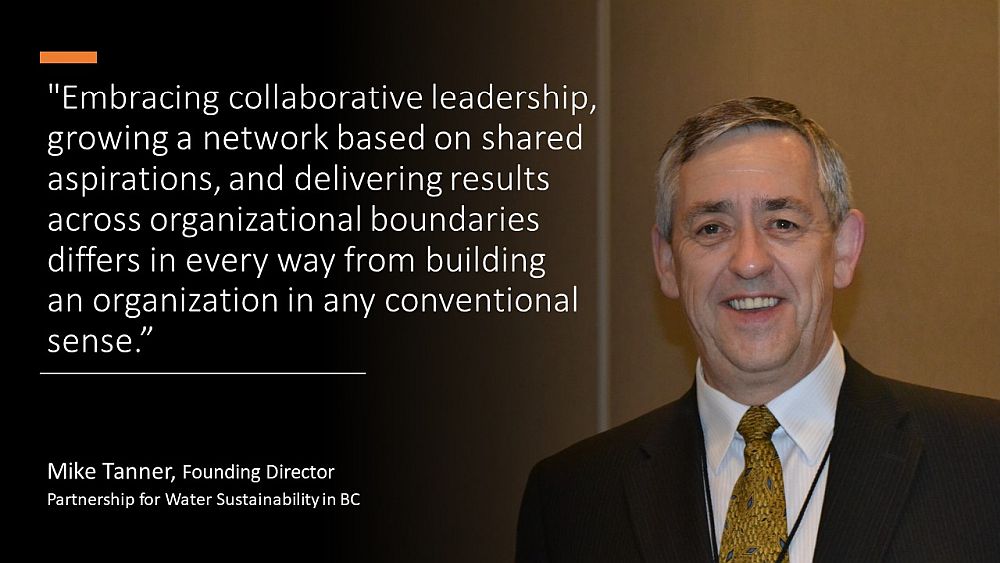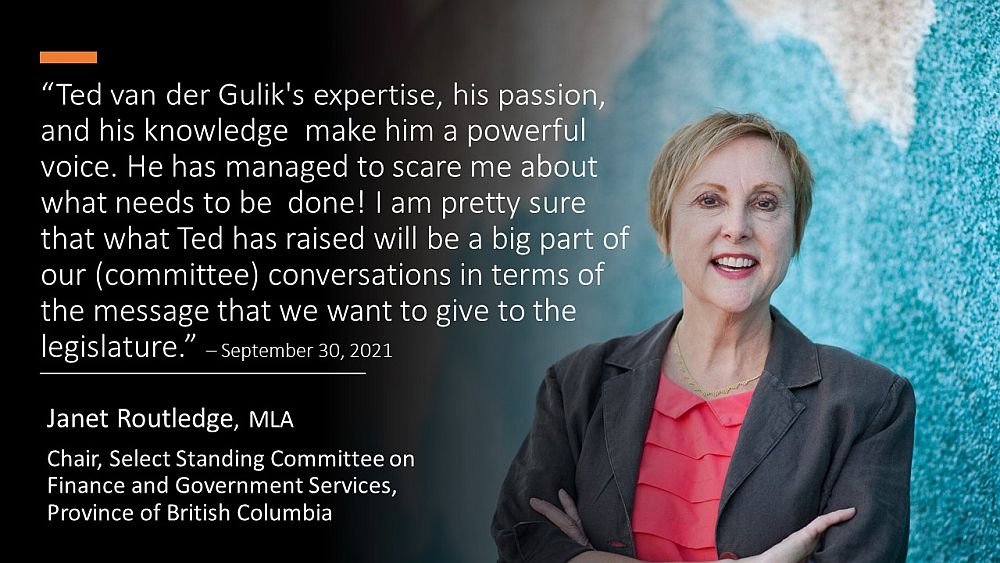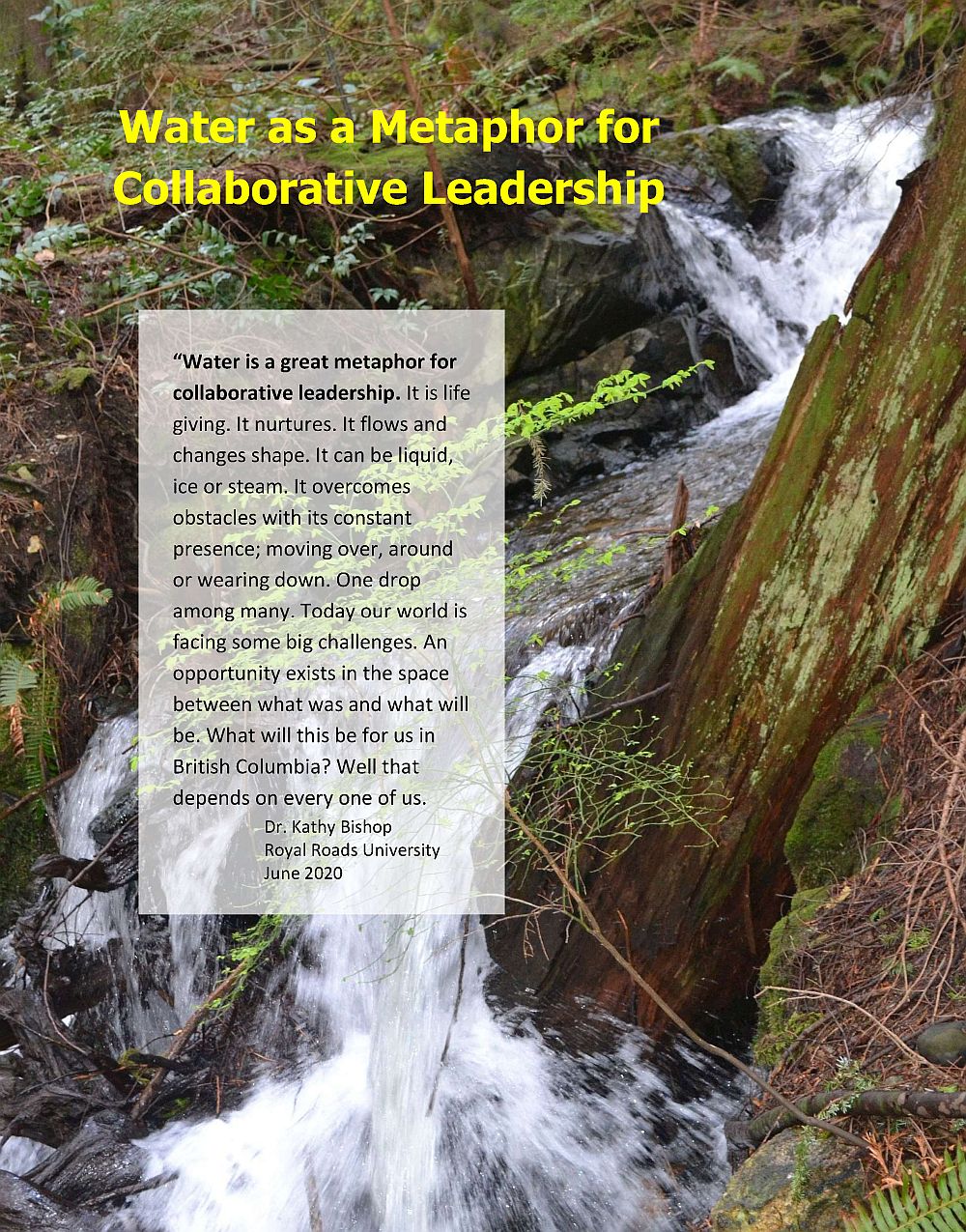2021 Annual Report for the Partnership for Water Sustainability in British Columbia
Note to Reader:
The Partnership’s Annual Report 2021 is written as a communication tool to present a big picture look at the work of The Partnership. The format comprises a set of “30-second takeaways” to illustrate the breadth and depth of initiatives and programs. Click on the cover image below to download a copy of the document.
The Living Water Smart Network is guided by a shared vision.
By pulling threads of understanding from the past through to the present and future, it would help communities reconnect people, fish, land and water in altered landscapes.
A Non-Profit that Provides Services to Government
The Partnership is a registered non-profit society, a legal entity. Operationally, however, we function as the hub for a network in the local government setting – the Living Water Smart Network. We are guided by the collaborative leadership model. An over-arching goal of collaboration is to align efforts around a shared vision for “settlement, economy and ecology in balance”.

This approach reflects The Partnership genesis, first as a technical committee and then as a roundtable, before morphing into the present non-profit legal entity. We are growing the Living Water Smart Network. We are not building a conventional organization.
Collaborative leadership uses the power of influence rather than positional authority to engage and align individuals and organizations within a network, and deliver results across organizational boundaries.
The network is the ultimate source of strength of The Partnership. The network also holds the key to intergenerational collaboration. It is how we build bridges of understanding and pass the baton from the past to the present and future.
For The Partnership to be successful in facilitating changes in practice over the long-term, the hard work must be done by our partners. This means the work of The Partnership must be aligned with and support their organizational aspirations and objectives.

EDITOR’S PERSPECTIVE
“At the beginning of 2021, the Partnership leadership reflected on our long-term commitment to collaborative leadership and growing a network. From the outset, we had vowed never to fall into the trap of concentrating our energies on building an organization and thus losing sight of “the mission”. This view of the world reflected our history as a roundtable,” stated Kim Stephens, Waterbucket eNews Editor and Executive Director, Partnership for Water Sustainability in British Columbia.
“Are there other precedents for our approach, we wondered? Or are we unique? In 2015, for example, United States Senator Patrick Leahy reached out to The Partnership to provide an inspirational address at his 2nd Environmental Summit held in Burlington, Vermont. When I asked why they approached us, the summit organizers responded that they could find nothing in North America comparable to what The Partnership is doing.”
“Although our Vermont experience provided anecdotal evidence, we decided it was time to research the social science literature to definitively answer this question: Has anyone else tried to do what we have been doing for the past two decades under the “collaboration umbrella” that is the Water Sustainability Action Plan? “

Is Our Experience Unique?
“Mike Tanner, a founding Director, took on the research task. He found the groundbreaking paper co-authored by Dr. Jane Wei Stillern in 2008. Published in the Stanford Social Innovation Review, her work provided us with the textbook reference to describe what we are doing intuitively!”
“Fast forward to October 2021. The Partnership leadership reached out to Jane via email. We wanted to learn more about her research findings. Jane responded within minutes. Were we ever impressed. Within days, we met via Zoom. Jane kicked off the conversation by telling us that she had heard about the work of the Partnership and had long wanted to connect with us.”
“The focus of Jane’s research is on non-government organizations (NGOs). The Partnership is unique in that our main focus is on evolving a network that is government-based. Governments, especially local governments, are also nonprofits. From experience, we can draw the conclusion that the research findings for an NGO-based network apply equally well to the Partnership’s government-based network.”
“Jane Wei Stillern introduced us to a set of four counter-intuitive principles that are critical to collaboration success. Her findings offer insights into how champions in the local government and stream stewardship sectors can ensure that their collaborative efforts can have an impact that is dramatically greater than the sum of the individual parts.”

Principles for Effective Networks
Focus on mission before organization. Effective network leaders build strategies that advance the mission even when it does not result in direct benefits to their organization.
Build partnerships based on trust, not control. Leaders depend upon shared values and trust rather than top-down controls and accountability systems.
Promote others rather than yourself. Network leaders exhibit a strong norm of humility above all else, sharing credit and foregoing opportunities for individual advancement and institutional growth and brand building.
Build constellations rather than lone stars. Leaders who catalyze successful networks acknowledge their weaknesses as readily as their strengths. The goal is to build the larger system that is necessary for delivering on the mission, not to become the “market leader”.

JANE WEU-SKILLERN’S RESEARCH WORK IS GUIDED BY THIS MISSION STATEMENT: “To champion network leaders, and the networks that they serve, to nurture change on the challenges that dwarf us all.”
“Based on fifteen years of research on successful networks across a range of fields and contexts, and more than two centuries of collective experience of nonprofit network leaders themselves, the four counter-intuitive principles are the common norms that effective networks have in common,” states Dr. Jane Wei-Skillern.
“They challenge us to examine the characteristics of our own collaborations and they provide guidance on how to ensure that the impact of our collective work is dramatically greater than the sum of the individual parts.”
To Learn More:
Intergenerational Context for the Living Water Smart Network


2021-An Extraordinary Year
Reflections by Ted van der Gulik, Partnership President
Looking back, 2021 is an extraordinary year of accomplishment for the Partnership. We continued to elevate our game and in so doing demonstrated what is possible. We provided leadership for a range of initiatives of provincial importance. These four stand out:
- Groundwater Licensing is a cornerstone of the Water Sustainability Act. It is the biggest endeavour the Province of BC has taken on in its water management history.
- EAP, the Ecological Accounting Process, is game-changing. It provides local governments with a methodology and metrics to integrate stream corridor systems within Asset Management Budgets.
- BC Landscape Water Calculator is aligned with the next iteration of the provincial government’s Water Conservation Condition. This is the contractual mechanism for infrastructure grants.
- Blue Ecology is an ecological philosophy whose time has come. Interweaving Indigenous knowledge and Western science would be the foundation for a whole-system approach to Water Reconciliation.
These successes were achieved through the power of collaborative leadership. The process involves bringing the right people together in constructive ways with good information, such that they create authentic visions and strategies for addressing the shared concerns of their organizations and communities.
Looking ahead to 2022, the Partnership and our partners in the Living Water Smart Network are poised to build on these breakthrough initiatives. We will also be celebrating the 20th anniversary of Stormwater Planning: A Guidebook for British Columba. The Partnership is the steward for the Guidebook.
In 2022, the Partnership will publish the fourth in the Beyond the Guidebook series of guidance documents. Tentatively titled Flowing Towards “Water Reconciliation” within the Georgia Basin/Salish Sea, Beyond the Guidebook 2022 will showcase parallel streams of effort by our local government partners in five sub-regions over the past two decades. This work is ongoing under the umbrella of the Georgia Basin Inter-Regional Education Initiative, launched in 2012.
GROUNDWATER LICENSING:
In mid-September 2021, The Partnership released a Groundwater Licensing Primer that laid out WHAT must happen to rectify a chaotic situation, provide a dedicated budget, and get groundwater licensing implementation back on track.
EAP, the Ecological Accounting Process:
The goal of making the financial case for the stream has been realized through a systematic process founded on case study applications. A notable outcome is Riparian Deficit, a new way of defining “loss of riparian integrity”.

BC Landscape Water Calculator:
BC’s new reality is longer, drier summers. Targeting seasonal outdoor water use represents the best opportunity to achieve “water use in balance with a changing water cycle”.

Blue Ecology / Water Reconciliation:
More than a decade ago, international recognition gave Michael Blackstock’s Blue Ecology research early credibility and profile. The initiative is guided by a vision to build a bridge between two cultures through a water-first approach.
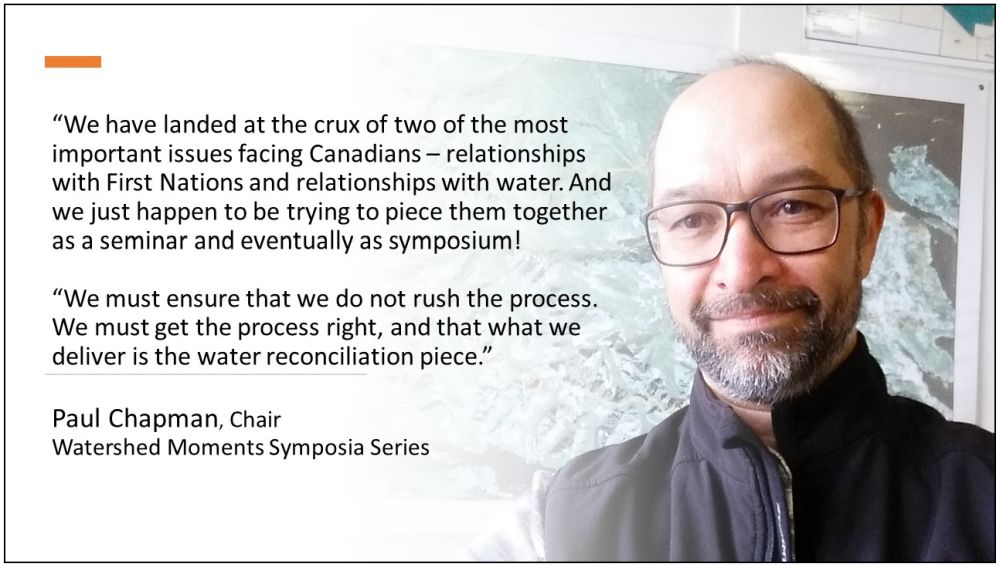
Georgia Basin Inter-Regional Educational Initiative (IREI):
Launched in 2012, the IREI facilitates peer-based education among local governments located on the east coast of Vancouver and in the Lower Mainland. In 2016, five Regional Boards – Cowichan Valley, Nanaimo Region, Comox Valley, Capital Region, and Metro Vancouver – recommitted through 2021 to collaborate and work as a team. 2022 is the 10th anniversary of the IREI.
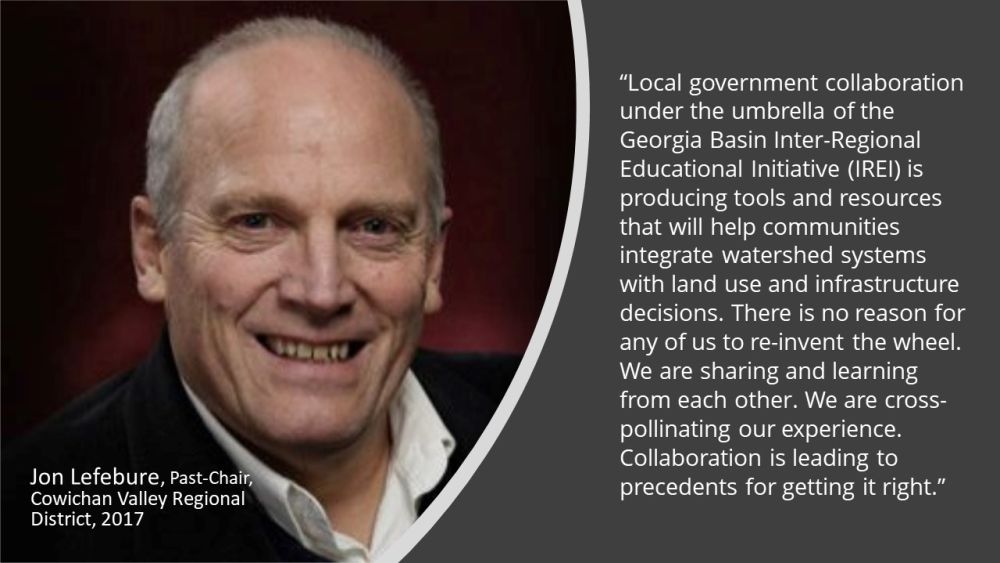
About the Partnership for Water Sustainability in BC
Incorporation of the Partnership for Water Sustainability in British Columbia as a not-for-profit society on November 19, 2010 was a milestone moment. Incorporation signified a bold leap forward. The Partnership evolved from a technical committee in the 1990s, to a “water roundtable” in the first decade of the 2000s, and then to a legal entity. The Partnership has its roots in government – local, provincial, federal.
The umbrella for Partnership initiatives and programs is the Water Sustainability Action Plan for British Columbia. In turn, the Action Plan is nested within Living Water Smart, British Columbia’s Water Plan. Released in 2008, Living Water Smart was the provincial government’s call to action, and to this day transcends governments.
Conceptual Framework for Inter-Generational Collaboration
Technical knowledge alone is not enough to resolve water challenges facing BC. Making things happen in the real world requires an appreciation and understanding of human behaviour, combined with a knowledge of how decisions are made. It takes a career to figure this out.
The Partnership has a primary goal, to build bridges of understanding and pass the baton from the past to the present and future. To achieve the goal, the Partnership is growing a network in the local government setting. This network embraces collaborative leadership and inter-generational collaboration.
Application of Experience, Knowledge and Wisdom
The Partnership believes that when each generation is receptive to accepting the inter-generational baton and embracing the wisdom that goes with it, the decisions of successive generations will benefit from and build upon the experience of those who went before them.
The Partnership leadership team brings experience, knowledge, and wisdom – a forceful combination to help collaborators reach their vision, mission, and goals for achieving water sustainability. When they are successful, the Partnership is successful.
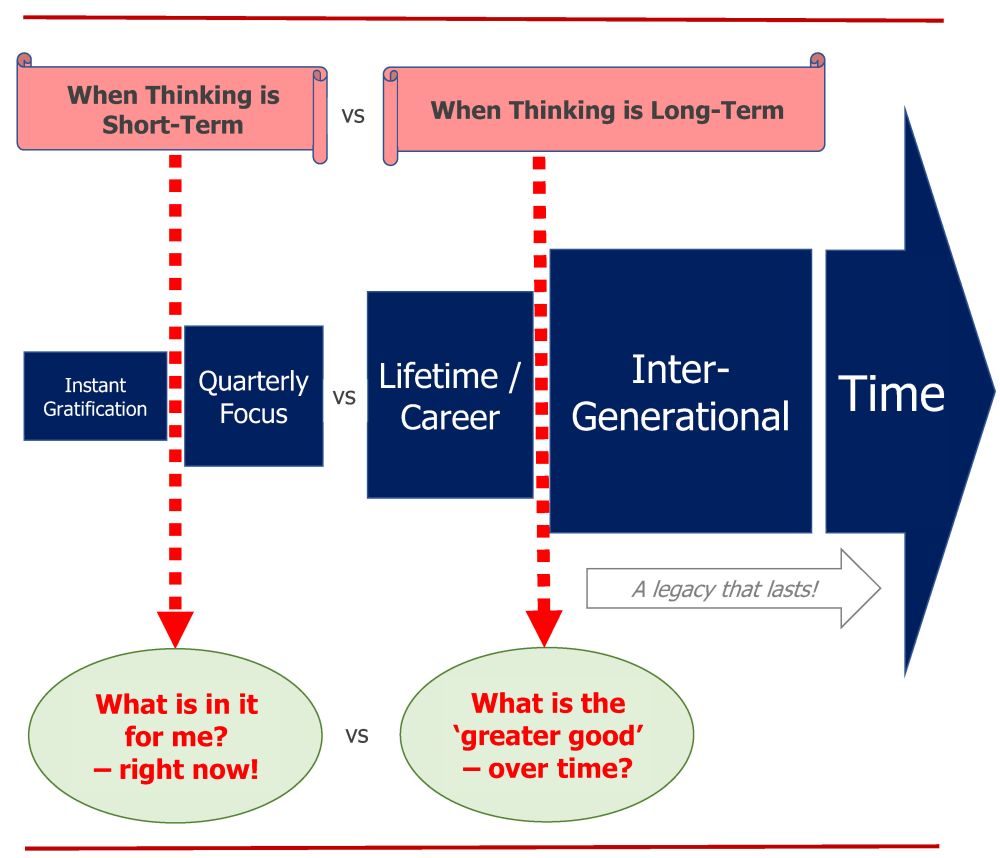
The Time Continuum graphic (above) conceptualizes the way of thinking that underpins the inter-generational mission of the Partnership for Water Sustainability. Influence choices. Capitalize on the REACHABLE and TEACHABLE MOMENTS to influence choices.
TO LEARN MORE, VISIT: https://waterbucket.ca/about-us/
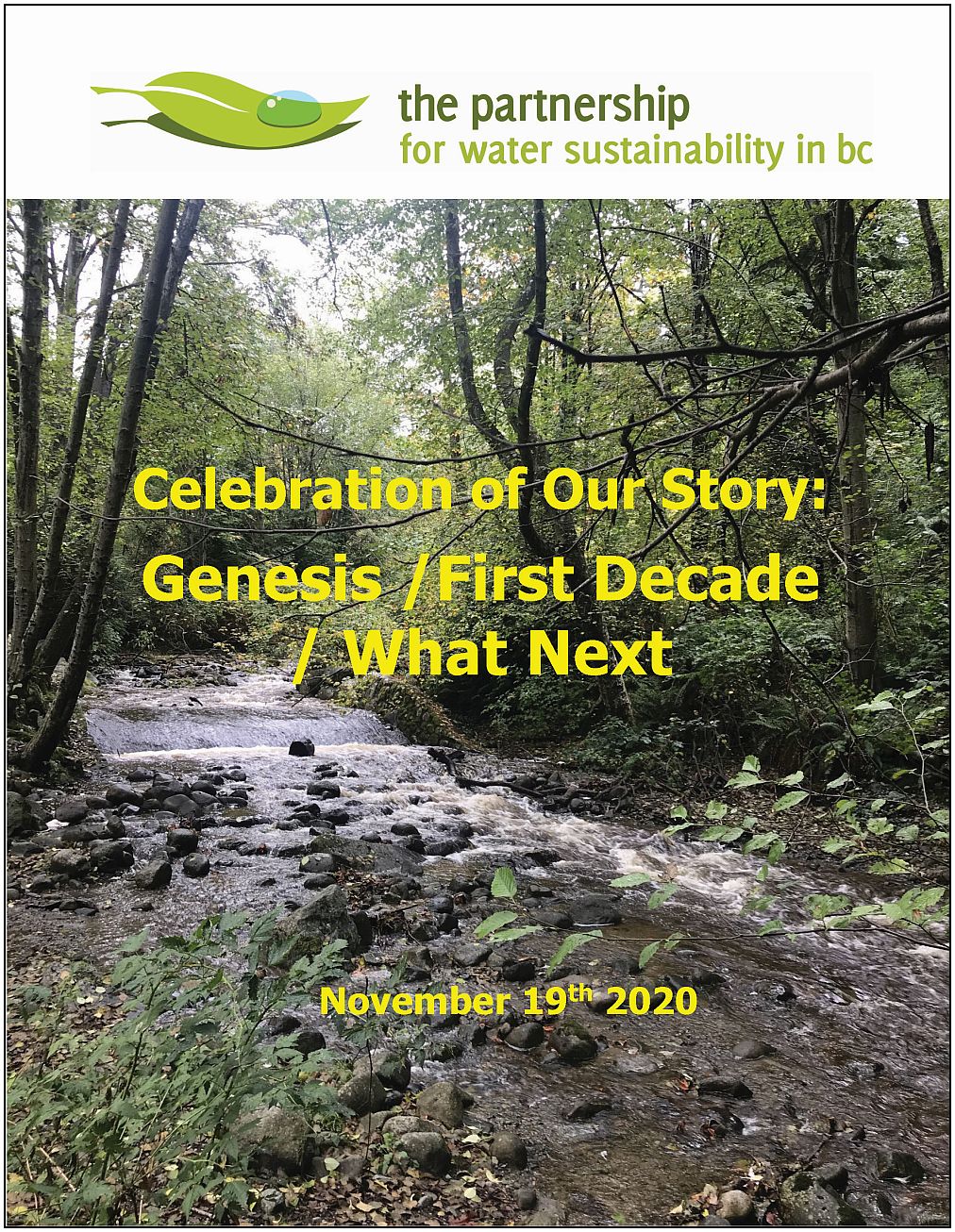
DOWNLOAD: https://waterbucket.ca/atp/wp-content/uploads/sites/9/2020/11/PWSBC_Story-of-First-Decade_Nov-2020.pdf


